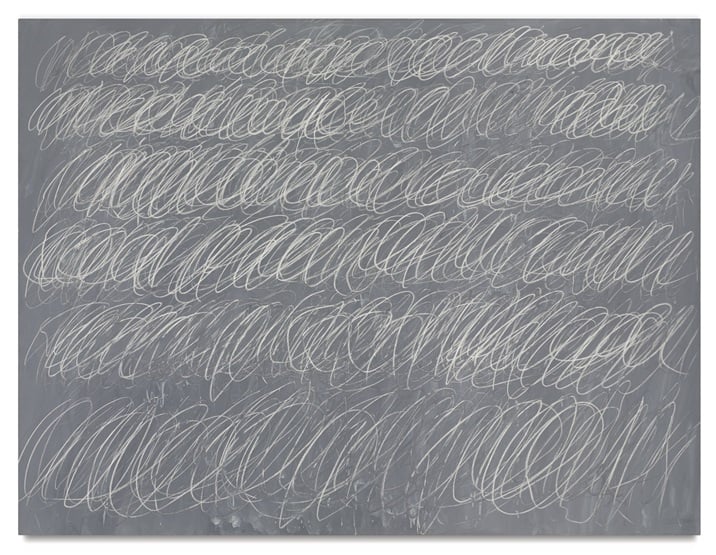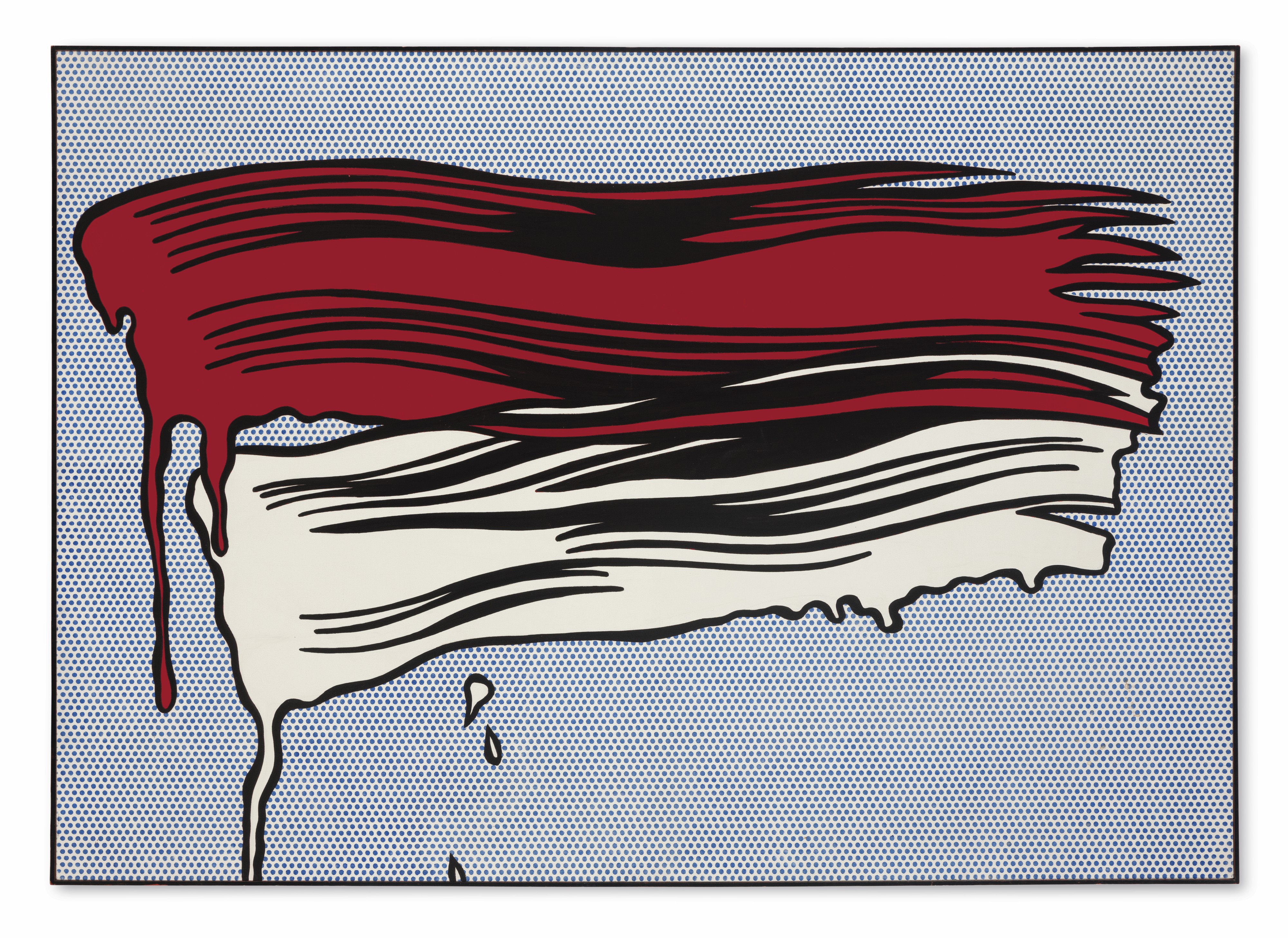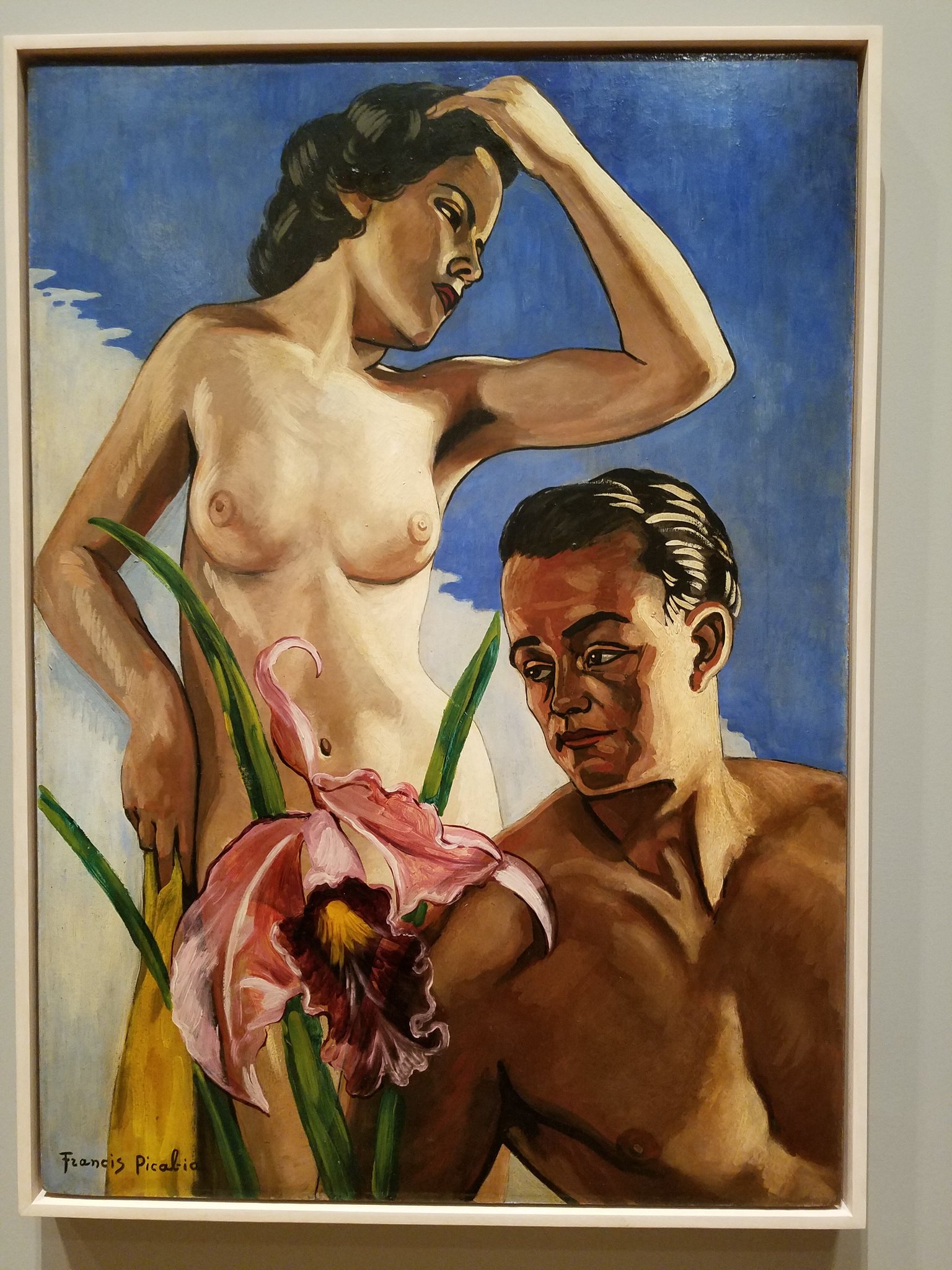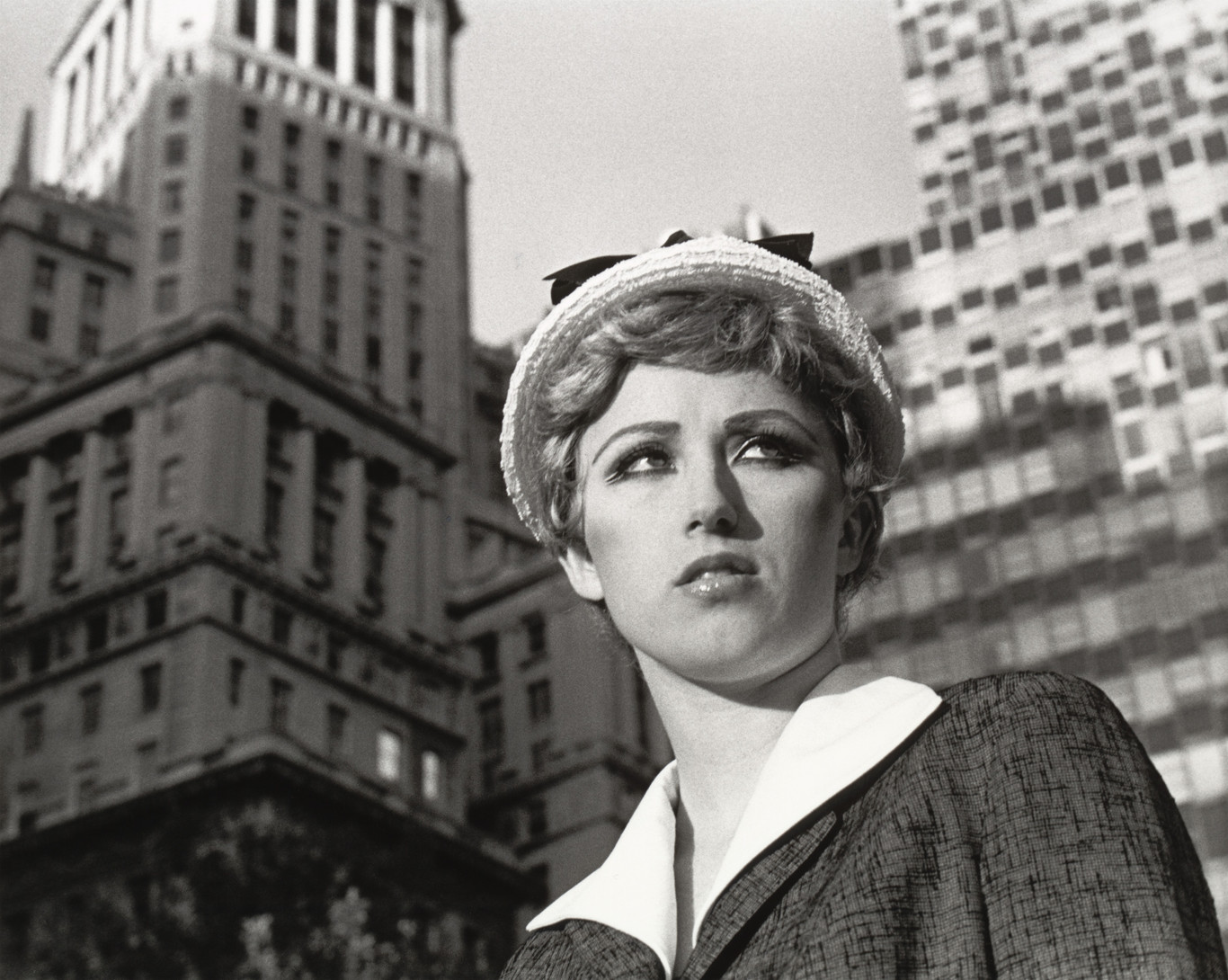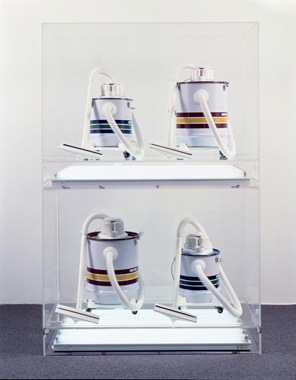Cy Twombly, Leda and the Swan, 1962, oil, lead pencil and wax crayon on canvas
Christie’s will offer Cy Twombly’s Leda and the Swan, 1962 as
a highlight of its May 17 Post-War and Contemporary Art Evening Sale.
This unequivocal tour de force has resided within a private collection
for over 25 years and has not been seen publicly in all that time. One
of two large format masterpieces to emerge from this unbridled subject, Leda and the Swan’s
heroic sister painting of the same title is among the most popular works on view within the permanent collection of the Museum of Modern Art in New York. Never before at auction, the painting has only had two private owners and is completely fresh to the market (estimate $35-55million).
Koji Inoue, International Director, Post-War and Contemporary Art, remarked:
With its vigorous application of paint and affectionate use of the hand, Leda and the Swan is an apex example of the artist’s fusing of myth, eroticism and history. Revisiting the story of Leda’s seduction by the Greek god Zeus, or his Roman counterpart, Jupiter, in the form of a swan*, Twombly’s adaptation of this classical story inspired an increasingly baroque tendency that emerged in his work during the early 1960s, dramatically enriching the strongly tactile and sensual nature of his art. Throughout these paintings from the early 1960s, the artist not only arrives at, but fully executes some of the most empowering themes found throughout his oeuvre.
Leda and the Swan is part of a cycle of works that resulted from the explosive and highly physical release of passion, seduction and visceral energy that had defined Twombly’s Ferragosto paintings, which were executed throughout the hot summer months of 1961. Demonstrating this new, distinctly Baroque mix of eroticism and violence, Leda and the Swan exemplifies the “blood and foam” style that dominated the artist’s work until 1966.
The myth of “Leda and the Swan” is among dramatic and tumultuous themes in Twombly’s work of the early 1960s. A magnum opus of the artist’s oeuvre, Leda and the Swan fully articulates Twombly’s desire to defeat tradition even as he engaged with it. Immersing himself in ancient Greek and Roman literature, Twombly demonstrates the breadth of the artist’s cultural immersion in his Mediterranean surroundings.
The auction record for Cy Twombly was set by Untitled (New York City), oil based house paint and wax crayon on canvas, 1968, which realized $70,530,000 in November 2015.
More Highlights from the Post-War And Contemporary Evening Sale
Sigmar Polke’s Frau mit Butterbrot,1964.
An early iconic masterpiece, the present canvas dates from the year of Polke’s first Rasterbilder, the ubiquitous raster-dot paintings that mimicked the halftone printing process of newspapers and magazines.
Frau mit Butterbrot is a rare, formative work that demonstrates the scathing critique of mass media culture that Polke and his fellow “Capitalist Realist” painters, Gerhard Richter, Manfred Kuttnerand Konrad Lueg proposed in their radical exhibits of the early 60s. Its biting critique of bourgeois norms and the meticulous, time-consuming nature of its large-scale execution make Frau mit Butterbrot one of the most significant paintings of Polke’s early career. Both charming vixen and proper hausfrau, Polke’s cunning, perfectly-coiffed subject is the wholesome German counterpart to Lichtenstein’s comic-book heroines and Warhol’s starlets. Created at a critical, early juncture, Frau mit Butterbrot slyly demonstrates the significant themes that would sustain the artist for the
duration of his prolific career.
Francis Picabia’s Adam et Ève, 1941, was recently featured in the Museum of Modern Art’s 2016-2017 retrospective of the artist’s expansive career. This striking canvas belongs to a series of paintings that the artist began in the early 1930s. The appropriation of mass media had been a central part of the artist’s oeuvre since World War I. Long before Rauschenberg, Warhol, Lichtenstein and Koons embraced appropriation, Francis Picabia wryly played with the concepts of artistic authorship and individual skill that were to become among the central doctrines of modern painting. His defiantly anti-modernist style demonstrates his lifelong and unremitting predilection for overturning conventions of the avant-garde and pursuing new and radical approaches to art and art making, which paved the way for future generations of artists.
heroic sister painting of the same title is among the most popular works on view within the permanent collection of the Museum of Modern Art in New York. Never before at auction, the painting has only had two private owners and is completely fresh to the market (estimate $35-55million).
Koji Inoue, International Director, Post-War and Contemporary Art, remarked:
“Hidden from public view for over 25 years, we are thrilled to present one of Cy Twombly’s absolute masterpieces in Leda and the Swan, 1962. This is a remarkable painting that has been pursued by collectors for decades. Impregnated with paint passionately and poetically applied with the hand, brush and stick, Leda and the Swan, is one of the most vital canvases created during this transformative period in the artist’s career. Given its tremendous importance within the context of both Twombly’s oeuvre, and the canon of Post-War art, we are honored to have the opportunity to offer this work to the market after nearly thirty clandestine years. This is also a particularly exciting time for the Twombly market, given its overlap with the Centre Pompidou’s groundbreaking retrospective of the artist’s expansive career.”
With its vigorous application of paint and affectionate use of the hand, Leda and the Swan is an apex example of the artist’s fusing of myth, eroticism and history. Revisiting the story of Leda’s seduction by the Greek god Zeus, or his Roman counterpart, Jupiter, in the form of a swan*, Twombly’s adaptation of this classical story inspired an increasingly baroque tendency that emerged in his work during the early 1960s, dramatically enriching the strongly tactile and sensual nature of his art. Throughout these paintings from the early 1960s, the artist not only arrives at, but fully executes some of the most empowering themes found throughout his oeuvre.
Leda and the Swan is part of a cycle of works that resulted from the explosive and highly physical release of passion, seduction and visceral energy that had defined Twombly’s Ferragosto paintings, which were executed throughout the hot summer months of 1961. Demonstrating this new, distinctly Baroque mix of eroticism and violence, Leda and the Swan exemplifies the “blood and foam” style that dominated the artist’s work until 1966.
The myth of “Leda and the Swan” is among dramatic and tumultuous themes in Twombly’s work of the early 1960s. A magnum opus of the artist’s oeuvre, Leda and the Swan fully articulates Twombly’s desire to defeat tradition even as he engaged with it. Immersing himself in ancient Greek and Roman literature, Twombly demonstrates the breadth of the artist’s cultural immersion in his Mediterranean surroundings.
The auction record for Cy Twombly was set by Untitled (New York City), oil based house paint and wax crayon on canvas, 1968, which realized $70,530,000 in November 2015.
More Highlights from the Post-War And Contemporary Evening Sale
Roy Lichtenstein’s Red and
White Brushstrokes, from 1965, will highlight the May 17 Post-War and
Contemporary Auction in New York (estimate: $25,000,000-35,000,000).
Across this monumentally-scaled canvas, Lichtenstein took the essence of
Abstract Expressionism and reframed it as Pop. With its bold
representation of two brushstrokes loaded with red and white paint set
against a backdrop of blue Ben-Day dots, Lichtenstein calls into
question the revered status of the painterly mark. Never before offered
at auction, the present work is one of only a handful of canvases from
Lichtenstein’s pivotal Brushstroke series to remain in private hands.
The distinctive subject of Red and White Brushstrokes puts it at the very heart of Roy Lichtenstein’s legacy. Its iconic style is double edged, apparently naive but actually highly sophisticated. By taking something as fundamental as a the mark made by the stroke of a brush and rendering it in the style of a mass produced comic, Lichtenstein set out to derail over a thousand years of art history. His choice of images as well as his simplified reductive style, highlighted his objectives intentions in a way that made the paintings both accessible to the general public and irritating to traditional academic art scholars who viewed him as unsophisticated. Yet, with works such as this, Lichtenstein emerged as one of the most intelligent and innovative artists of the Pop Art movement.
Andy Massad, Deputy Chairman, Post-War and Contemporary Art, remarked:
The present work belongs to Lichtenstein’s Brushstrokes series, one of the most significant bodies of work of the artist’s long and prolific career. The group of 14 canvases was produced during a span of only a few months and many are now regarded as pivotal works from the Pop Art movement. Most examples now exist in major international museum collections. These include Brushstrokes (on long-term loan to the Moderna Museet, Stockholm), Big Painting, (Kunstsammlung Nordrhein-Westfalen, Düsseldorf), Little Big Painting (Whitney Museum of American Art, New York), Yellow Brushstroke I (Kunsthaus, Zürich), and Brushstroke with Splatter (Art Institute of Chicago).
Lichtenstein’s Brushstroke series is often interpreted as a sly comment on the artistic dominance of Abstract Expressionism at the time of its conception. And particularly the authoritarian gestures of artists Willem de Kooning, Jackson Pollock and Franz Kline. During the movement’s heyday these autographical marks were often regarded as the ultimate demonstration of the artist’s prowess.
With Red and White Brushstrokes Lichtenstein began to challenge this hegemony, and by interpreting these spontaneous marks in a commercial, mass-produced style, he questioned the authority of these purportedly inimitable gestures. Although the Brushstroke paintings were informed by Abstract Expressionism, their sources are more varied.
Like Lichtenstein's more familiar works, the starting point was a comic strip. One of the artist's first Brushstroke paintings was a direct reprisal of a panel from the comic strip "The Painting" a horror story from Charlton Comics' Strange Suspense Stories, no. 72 (October 1964). Here, the cartoonist indicates paint in two overlapping strokes of paint; it is from this comic strip image that Lichtenstein developed the visual vocabulary for his Brushstroke series and roots them in the iconography of his earlier paintings.
The distinctive subject of Red and White Brushstrokes puts it at the very heart of Roy Lichtenstein’s legacy. Its iconic style is double edged, apparently naive but actually highly sophisticated. By taking something as fundamental as a the mark made by the stroke of a brush and rendering it in the style of a mass produced comic, Lichtenstein set out to derail over a thousand years of art history. His choice of images as well as his simplified reductive style, highlighted his objectives intentions in a way that made the paintings both accessible to the general public and irritating to traditional academic art scholars who viewed him as unsophisticated. Yet, with works such as this, Lichtenstein emerged as one of the most intelligent and innovative artists of the Pop Art movement.
Andy Massad, Deputy Chairman, Post-War and Contemporary Art, remarked:
“Red and White Brushstrokes is a Pop masterpiece, but one that effectively draws on centuries of artistic tradition. Lichtenstein was an enthusiastic student of art history, as with Warhol, distilled through the crucible of Marcel Duchamp. The Brushstroke paintings were some of the first canvases in which he delved into the art historical canon as source material for his work. Using Abstract Expressionism, Renaissance painting and comic books as inspiration, Lichtenstein simultaneously canonized the work of his predecessors and eviscerated the parameters surrounding fine art. With this canvas he embraced the appearance of mechanical reproduction with a palette of red, white, and blue to form brushstrokes that wave like a flag of purely American painting, commenting on, but revolutionarily apart from European tradition. This work epitomizes the artist’s ability to harness so much implication into deceptively simple imagery.”
The present work belongs to Lichtenstein’s Brushstrokes series, one of the most significant bodies of work of the artist’s long and prolific career. The group of 14 canvases was produced during a span of only a few months and many are now regarded as pivotal works from the Pop Art movement. Most examples now exist in major international museum collections. These include Brushstrokes (on long-term loan to the Moderna Museet, Stockholm), Big Painting, (Kunstsammlung Nordrhein-Westfalen, Düsseldorf), Little Big Painting (Whitney Museum of American Art, New York), Yellow Brushstroke I (Kunsthaus, Zürich), and Brushstroke with Splatter (Art Institute of Chicago).
Lichtenstein’s Brushstroke series is often interpreted as a sly comment on the artistic dominance of Abstract Expressionism at the time of its conception. And particularly the authoritarian gestures of artists Willem de Kooning, Jackson Pollock and Franz Kline. During the movement’s heyday these autographical marks were often regarded as the ultimate demonstration of the artist’s prowess.
With Red and White Brushstrokes Lichtenstein began to challenge this hegemony, and by interpreting these spontaneous marks in a commercial, mass-produced style, he questioned the authority of these purportedly inimitable gestures. Although the Brushstroke paintings were informed by Abstract Expressionism, their sources are more varied.
Like Lichtenstein's more familiar works, the starting point was a comic strip. One of the artist's first Brushstroke paintings was a direct reprisal of a panel from the comic strip "The Painting" a horror story from Charlton Comics' Strange Suspense Stories, no. 72 (October 1964). Here, the cartoonist indicates paint in two overlapping strokes of paint; it is from this comic strip image that Lichtenstein developed the visual vocabulary for his Brushstroke series and roots them in the iconography of his earlier paintings.
Sigmar Polke’s Frau mit Butterbrot,1964.
An early iconic masterpiece, the present canvas dates from the year of Polke’s first Rasterbilder, the ubiquitous raster-dot paintings that mimicked the halftone printing process of newspapers and magazines.
Frau mit Butterbrot is a rare, formative work that demonstrates the scathing critique of mass media culture that Polke and his fellow “Capitalist Realist” painters, Gerhard Richter, Manfred Kuttnerand Konrad Lueg proposed in their radical exhibits of the early 60s. Its biting critique of bourgeois norms and the meticulous, time-consuming nature of its large-scale execution make Frau mit Butterbrot one of the most significant paintings of Polke’s early career. Both charming vixen and proper hausfrau, Polke’s cunning, perfectly-coiffed subject is the wholesome German counterpart to Lichtenstein’s comic-book heroines and Warhol’s starlets. Created at a critical, early juncture, Frau mit Butterbrot slyly demonstrates the significant themes that would sustain the artist for the
duration of his prolific career.
Francis Picabia’s Adam et Ève, 1941, was recently featured in the Museum of Modern Art’s 2016-2017 retrospective of the artist’s expansive career. This striking canvas belongs to a series of paintings that the artist began in the early 1930s. The appropriation of mass media had been a central part of the artist’s oeuvre since World War I. Long before Rauschenberg, Warhol, Lichtenstein and Koons embraced appropriation, Francis Picabia wryly played with the concepts of artistic authorship and individual skill that were to become among the central doctrines of modern painting. His defiantly anti-modernist style demonstrates his lifelong and unremitting predilection for overturning conventions of the avant-garde and pursuing new and radical approaches to art and art making, which paved the way for future generations of artists.
Cindy Sherman, Untitled, Film Still #21
gelatin silver print, Executed in 1978
Jeff Koons, New Shelton Wet/Drys 5-Gallon, 10-Gallon, Doubledecker
plexiglas, fluorescent lights and four Shelton Wet/Dry vacuums, 1981-1986
Jeff Koons, New Shelton Wet/Drys 5-Gallon, 10-Gallon, Doubledecker
plexiglas, fluorescent lights and four Shelton Wet/Dry vacuums, 1981-1986
Gerhard Richter, Schober
oil on canvas, Painted in 1984

